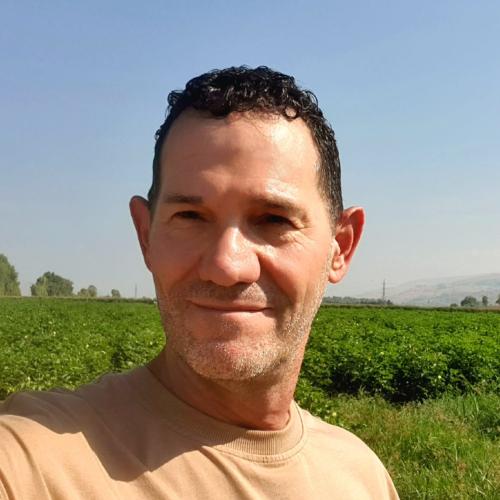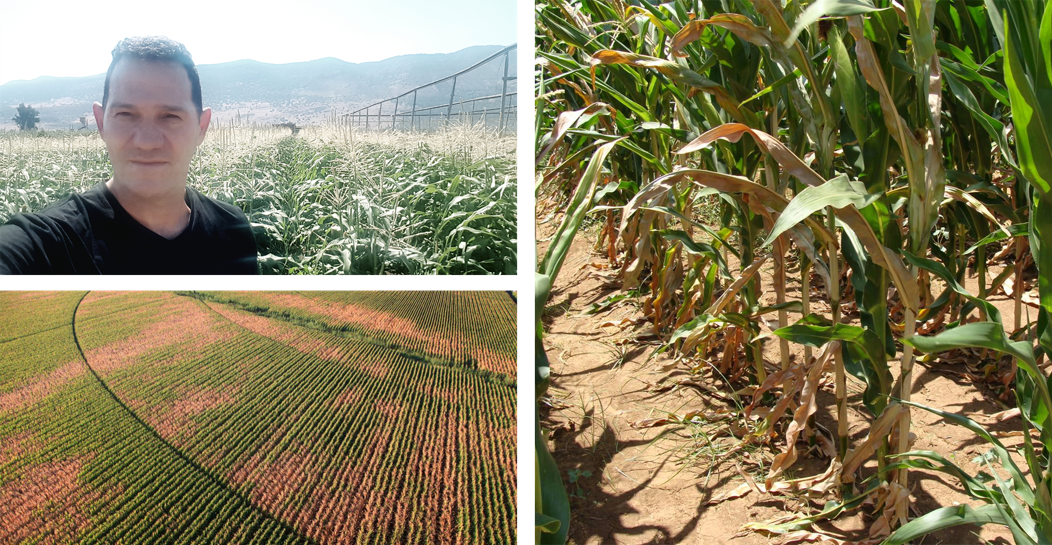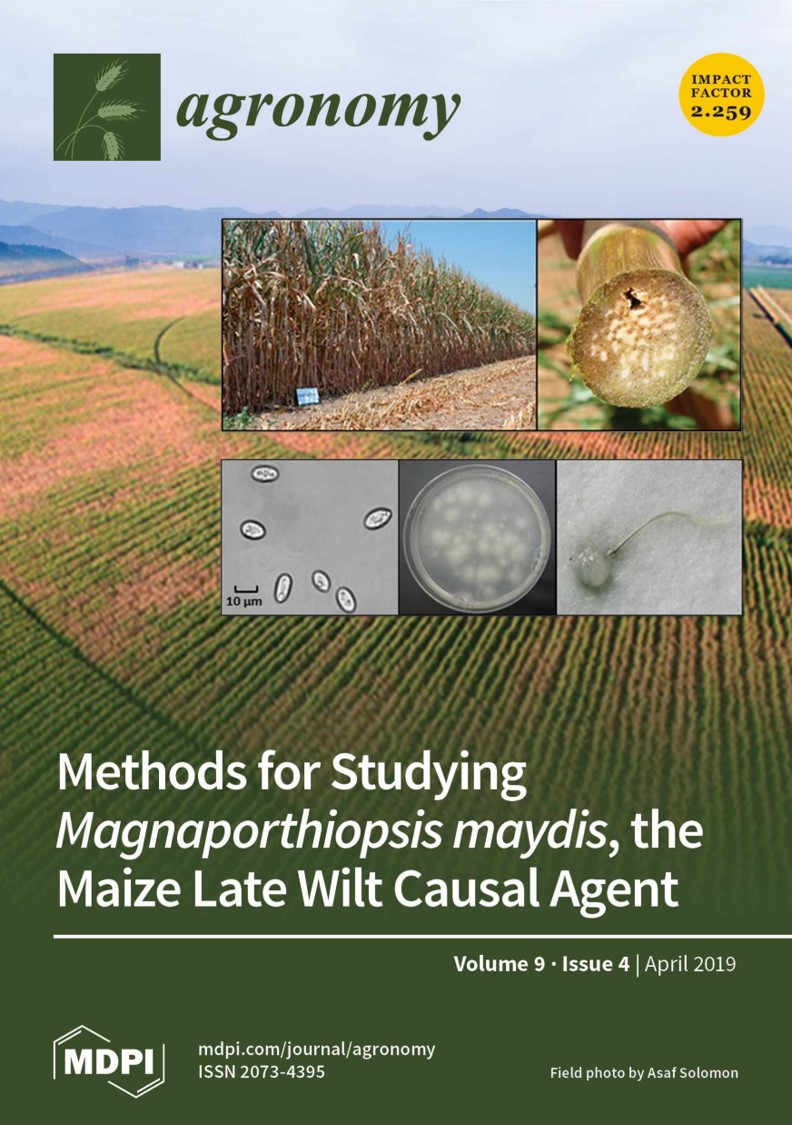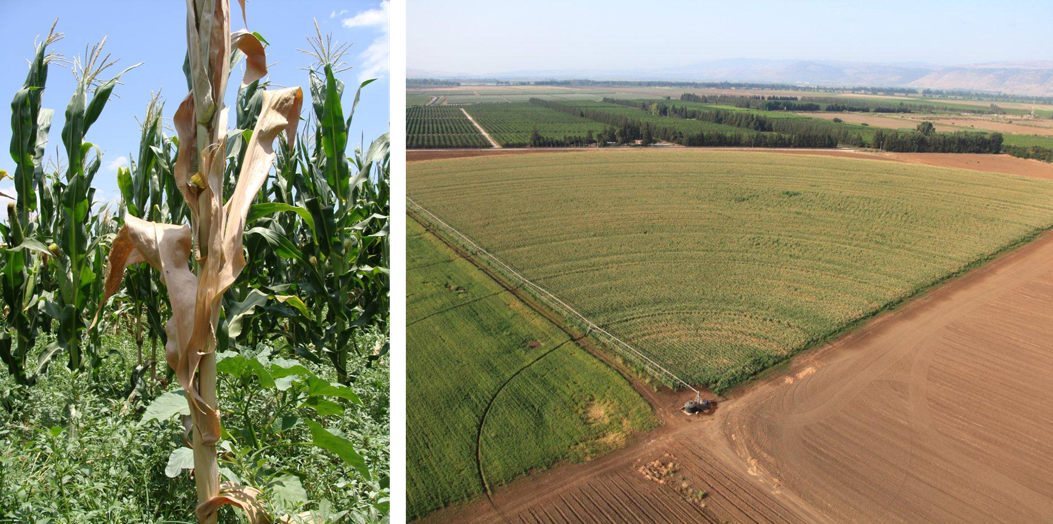
Lab Website
Dr. Ofir Degani’s Research Group
Dr. Ofir Degani completed his Ph.D. at the Technion-Israel Institute of Technology (Haifa, Israel), specializing in genetic engineering approaches in phytopathology. He carried out his post-doctoral studies at the Migal-Galilee Research Institute (Israel). Currently, Dr. Degani serves as the research group director of this institute’s Phytopathology and Crop Protection Laboratory and a senior staff member at Tel-Hai College (Israel). His research is based on molecular, biochemical, and microbial approaches for understanding and preventing plant fungal diseases. Specifically, his research group is working on (1) developing biological, chemical, and agrotechnical controls for plant diseases, including Maize late wilt and stalk rot, Cotton charcoal rot, and Onion basal rot. (2) Study and manipulate the plant microbiome to provide an eco-friendly toolkit to protect plants. (3) Investigating the interactions between pathogens and their role in plant pathology to improve crop protection.
Current ongoing research topics:
- Study the “plant disease triangle” - the combined influence of the host plant, the fungal pathogen, and the environment on plant diseases and crop protection.
- Chemical protection (using seed treatments, spraying, and dripline irrigation) of maize, cotton, onion, and other crops against fungal pathogens.
- Develop biological approaches to protect crops from soil diseases. This includes the use of biocontrol agents (fungi and bacteria), strengthening soil mycorrhizal networks (the soil microbiome), manipulating the plants’ natural endophytes (the plant microbiome), and enhancing the plants’ natural defense system.
- Investigate the interactions between phytopathogenic fungi and their combined influence on crops' disease burst and severity.

Research plan and challenges
The growing trend of reducing pesticides’ use raises the need for alternative ways of coping with severe fungal diseases such as the late wilt of maize. Hence, we propose developing two environmentally friendly strategies to control maize late wilt disease, for which we have gained positive preliminary results. First, maintaining the continuity of soil mycorrhizal fungi between seasons has proven to be an essential factor in various field crops. Still, it has not yet been tested against the late wilt pathogen in Israel. The potential of strengthening soil mycorrhizal networks against the soil fungal pathogen has only now started to be revealed. The unique case of late wilt disease and the encouraging preliminary results provide an excellent opening stage and opportunity to investigate this control method. In order to do this, we will be required to:
- Repeat and establish the results using a greenhouse pot experiment over a full growth period
- Identify the mycorrhizal fungi involved
- Examine ways of strengthening the desired soil mycorrhizal networks
- Extend the research to field experiments
Similarly, in recent years we have conducted research with a new Trichoderma spp. isolates and achieved promising results. Consequently, we propose using the effective Trichoderma spp. or their extract in order to prevent the penetration and establishment of the M. maydis pathogen at the early growth period of maize. Thus we suggest using the late wilt controlling agents – Trichoderma isolates – and developing application methods to implement them. This goal will require several steps:
- Identifying the active compound/s in the Trichoderma spp. extract
- Examining ways of enhancing the secretion of these ingredients
- Applying the Trichoderma spp. hyphae or the extract and examining it in sprouts (up to the age of 40 days) under controlled conditions in a growth chamber
- Examining the Trichoderma spp. (extract and hyphae) seed coating against direct application of the fungi or their section to the soil under field conditions over a full growth period
We are now specializing in two important and severe corp diseases: cotton charcoal rot, caused by Macrophomina phaseolina, and onion (Allium cepa) basal rot caused by Fusarium sp. The challenges of developing efficient and cost-effective strategies to reduce the diseases’ damages include:
- Study these pathogens and their interactions with the host, under different environmental conditions.
- Undersending the involvement of other fungal phytopathogens in the diseases’ outburst and damages.
- Develop a new research tool-kit to study those diseases.
- Search for new ways (chemical, biological, and agro-mechanical) to restrict those diseases’ harmful effects and prevent their spreading.

Education
Ph.D. 2005, Biology, Technion Institute of Technology, Israel
M.Sc. 2001, Biology, Technion Institute of Technology, Israel
Academic and research experience
- 2007 – Present – Principal Investigator and Research group leader, Plant Sciences, Molecular Phytopathology lab, MIGAL - Galilee Research Institute, Israel
- 2005 – 2007 – Postdoctoral fellow in the laboratory of Dr. Doron Goldberg, MIGAL - Galilee Research Institute, Israel
- 2006 – Senior lecturer and staff member, Tel-Hai Academic College, Israel
- 2001 – Senior lecturer and staff member, Ohalo academic College, Israel
Other activity and service
- 2008 – 2021– Headmaster of the Tel-Hai Science and Knowledge Center for the Gifted and Talented Pupils, the Israel Ministry of Education, the Pedagogical Administration, the Division for the Gifted and Talented Pupils, Israel
- 2014 – 2017 – Head of the North Israel Group of Centers for Gifted and Talented Children, the Israel Ministry of Education, the Pedagogical Administration, the Division for the Gifted and Talented Pupils, Israel

Grants Awarded
Publications related to research by referral to the number in the list of publications.
Year | Funded by/ Amount | Topic | Co-Researcher | Role in Research |
2025 | Hazera Seeds, Israel. 15,000 NIS | Development of Trichoderma-Based Control for Onion Basal Rot Disease. | Dr. David Levi | PI |
2025 | Israel's Peanut Production and Marketing Council. 63,750 NIS | Examining the effectiveness of chemical and biological treatments for controlling the fungus Athelia rolfsii (Southern blight) and the earwig insect Euborellia Annulipis in peanuts. | Dr. Meri Dafni-Yalin (PI) Dr. Roni Gafni Dr. Onn Rabinovitz Dr. Liora Shaltiel-Harpaz | Co-PI |
2025 | Israel Council for Cotton Production and Marketing Ltd. 60,000 NIS | Development of an integrated management control for charcoal rot disease in cotton: a clay-based formula for the slow release of Azoxystrobin in the sowing strip and biological seed dressing. | Dr. Onn Rabinovitz Dr. Assaf Chen | PI |
2025 | RegenUP, Israel 16,000 NIS | Biological enrichment of cover plants, pre-growing cotton with minimum tillage, for protection against the charcoal rot disease (Macrophomina) | Dr. Onn Rabinovitz | PI |
2025 | Adama Haya biodynamics (Living Soil) Israel 25,000 NIS | Monitoring disease symptoms and conducting molecular surveillance of charcoal rot infestations in cotton plots following the pre-growth of cover plants and implementation of minimum tillage | Dr. Onn Rabinovitz | PI |
2025 | Israel's Organization of Extensive Cultivation. 29,000 NIS | Development of an integrated managing control for late wilt disease in corn: a clay-based formula for the slow release of Azoxystrobin in the sowing strip and biological seed dressing. | Dr. Onn Rabinovitz Mr. Yoav Golan | PI |
2024 | Adama Haya biodynamics (Living Soil) Israel 25,000 NIS | Monitoring disease symptoms and conducting molecular surveillance of charcoal rot infestations in cotton plots following the pre-growth of cover plants and implementation of minimum tillage | Dr. Onn Rabinovitz | PI |
2024-2025 | Israel Plant Council, Ministry of Agriculture 25,000 NIS | Development of an Eco-Friendly Interface Using Trichoderma spp. to Control Onion Basal Rot Disease | Mr. Elyahu Margalit | PI |
2024 | Migal – Galilee Research Institute 100,000 NIS | Developing an Azoxystrobin slow-release clay carrier for eco-friendly control of corn late wilt disease | Prof. Giora Rytwo | PI |
2024 | Israel Council for Cotton Production and Marketing Ltd. 70,000 NIS | Development of an eco-friendly pesticide interface, based on Trichoderma fungi, against the cause of cotton charcoal rot Publication: 7 | Dr. Onn Rabinovitz Dr. Assaf Chen | PI |
2023-2024 | Israel Plant Council, Ministry of Agriculture 28,000 NIS | Chemical control of Fusarium spp., the causal agents of onion (Allium cepa) basal rot Publications: 6, 9, 13 | Mr. Elyahu Margalit | PI |
2023 | Israel Council for Cotton Production and Marketing Ltd. 50,000 NIS | Development of an eco-friendly pesticide interface, based on Trichoderma fungi, against the cause of cotton charcoal rot Publication: 8 | Dr. Onn Rabinovitz Dr. Assaf Chen | PI |
2023 | Tel-Hai College, Israel, Science Relations Foundation 8,000 NIS | Support in funding equipment for research purposes | - | PI |
2023 | Israel's Organization of Extensive Cultivation. 20,000 NIS | Biological enrichment of fodder corn seeds against the late wilt disease Publication: 5 | Dr. Onn Rabinovitz Mr. Yoav Golan | PI |
2023 | Migal – Galilee Research Institute 100,000 NIS | Developing an Azoxystrobin slow-release clay carrier for eco-friendly control of corn late wilt disease | Prof. Giora Rytwo | PI |
2023 | ICA Israel (Jewish Colonization Association) 25,000 $ | Developing an Azoxystrobin slow-release clay carrier for eco-friendly control of corn late wilt disease | Prof. Giora Rytwo | PI |
2023 | Tel-Hai College, Israel, Science Relations Foundation 20,000 NIS | The formation process of Alternaria black spot disease in stored persimmons and its prevention through treatments with antioxidants | Dr. Shaul Naschitz Prof. Soliman Khatib Prof. Dov Prusky | PI |
2022 | Tel-Hai College, Israel, Science Relations Foundation 20,000 NIS | Developing an Azoxystrobin slow-release clay carrier for eco-friendly control of corn late wilt disease | Prof. Giora Rytwo | PI |
2022 | Israel Council for Cotton Production and Marketing Ltd. 55,000 NIS | Development of an eco-friendly pesticide interface, based on Trichoderma fungi, against the cause of cotton charcoal rot Publication: 11 | Dr. Onn Rabinovitz Dr. Assaf Chen | PI |
2022 | Israel Plant Council, Fruit Branch, Ministry of Agriculture 7,000 NIS | Isolation and identification of apple fruits' fungal pathogens | Dr. Shaul Naschitz (PI) | Co-PI |
2022 | Israel Plant Council, Ministry of Agriculture 17,000 NIS | Isolation and Identification of Fusarium spp., the causal agents of onion (Allium cepa) basal rot in northeastern Israel Publication: 6 | Mr. Shaul Graph Mr. Elyahu Margalit | PI |
2022 | Israel's Organization of extensive cultivation 20,000 NIS | Combined biological-chemical pesticide to prevent late wilt in corn Publications: 11, 19 | Dr. Onn Rabinovitz | PI |
2021 | Israel Plant Council, Ministry of Agriculture 18,000 NIS | Chemical control of Fusarium spp., the causal agents of onion (Allium cepa) basal rot Publications: 9, 13, 26 | Mr. Shaul Graph Mr. Elyahu Margalit | PI |
2021 | CTS Group 14,000 NIS | Cultivars' resistance assay for maize late wilt disease Publication: 12, 19 | Mr. Ran Yifa Dr. Assaf Chen | PI |
2021 | Migal – Galilee Research Institute 40,000 NIS | Purification and identification of Trichoderma asperellum secreted ingredients with antifungal activity against Magnaporthiopsis maydis, the maize late-wilt disease causal agent Publications: 15, 19, 21 | Prof. Soliman Khatib | PI |
2020 | Israel Plant Council, Ministry of Agriculture 10,500 NIS | Chemical control of Fusarium spp., the Causal Agents of Onion (Allium cepa) Basal Rot Publication: 13, 26 | Mr. Shaul Graph Mr. Elyahu Margalit | PI |
| Tel-Hai College, Israel, Science Relations Foundation 20,000 NIS | Eco-friendly control against corn late wilt by strengthening the soil mycorrhizal networks Publications: 16, 19, 20, 22 | Dr. Hagai Shemesh Dr. Onn Rabinovitz | PI |
2020 | Israel Council for Cotton Production and Marketing Ltd. 20,000 NIS | Biological control of Macrophomina phaseolina, the cotton charcoal rot disease causal agent Publications: 10, 17 |
| PI |
2020 | ICA – Migal accelerator, Israel 100,000 NIS | Isolation and identification of active ingredient against Magnaporthiopsis maydis, the maize Late-wilt disease causal agent Publications: 15, 19, 21 | Prof. Soliman Khatib | PI |
2019-2021 | Israel Ministry of Agriculture and Rural Development Chief Scientist 450,000 NIS (partial share 82,000 NIS) | Using remote sensing tools for the early detection and prevention of soil-borne diseases in field crops while reducing amounts of pesticides and increasing yield Publications: 12, 16, 18, 20, 23 | Dr. Assaf Chen (PI) Dr. Mery Dafny Yelin | Co-PI |
2019 | Israel Plant Council, Ministry of Agriculture 8,000 NIS | Isolation, characterization, and control of Fusarium spp. f. sp. cepae, the cause of the onion basal plate rot in northern Israel Publications: 26, 31 | Mr. Shaul Graph | PI |
2019 | Israel's Organization of extensive cultivation 25,000 NIS | The presence of Harpophora maydis in fodder maize, its interaction with other endophytes in the plant, and its effect on the nutritional value of the corn silage Publications: 18, 19, 20, 24 | Dr. Assaf Chen Dr. Onn Rabinovitz | PI |
2019 | Israel Council for Cotton Production and Marketing Ltd. 15,000 NIS | Interactions between Magnaporthiopsis maydis and Macrophomina phaseolina, the Causes of Wilt Diseases in Maize and Cotton Publications: 17, 19, 20, 32 | Dr. Roni Cohen | PI |
2018 | Israel Plant Council, Ministry of Agriculture 41,000 NIS | Isolation and Identification of Fusarium spp., the Causal Agents of Onion (Allium cepa) Basal Rot in Northeastern Israel Publication: 31 | Mr. Shaul Graph | PI |
2018 | Migal – Galilee Research Institute 90,000 NIS | Characterization of the profile of volatiles from the leaves and flowers of the cannabis plant in response to environmental stress | Dr. Haim Reuveni (PI) Dr. Soliman Khatib Prof. Jacob Vaya | Co-PI |
2018 | Migal – Galilee Research Institute 90,000 NIS | Biological control of pests and diseases in cannabis | Dr. Haim Reuveni (PI) Dr. Chen Katz | Co-PI |
2018 | Migal – Galilee Research Institute 140,000 NIS | Biological control against Harpophora maydis, the maize Late-wilt disease causal agent Publications: 19, 20, 21, 23, 25 |
| PI |
2018 | Israel Council for Cotton Production and Marketing Ltd. 17,000 NIS | Interactions between Magnaporthiopsis maydis and Macrophomina phaseolina, the Causes of Wilt Diseases in Maize and Cotton Publications: 17, 19, 20, 32 | Dr. Roni Cohen Mr. Shaul Graph | PI |
2018 | Israel's Organization of extensive cultivation 25,000 NIS | Thermal detection and chemical control of the maize late wilt causing agent, Harpophora maydis Publications: 19, 20, 30 | Dr. Moshe Meron Dr. Assaf Chen Mr. Shaul Graph | PI |
2017 | Netafim Ltd. Israel 8,000 NIS | Improved chemical control against the cause of late wilt in corn Publications: 19, 20, 30, 34 | Dr. Onn Rabinovitz Mr. Shaul Graph | PI |
2017 | Migal – Galilee Research Institute 45,000 NIS | Biological control against Harpophora maydis, the maize Late-wilt disease causal agent Publications: 18, 19, 23, 25 |
| PI |
2015- 2017 | Israel Ministry of Agriculture and Rural Development Chief Scientist 420,000 NIS | Protection and control against Harpophora maydis, the causing agent of maize late wilt Publications: 11, 19, 20, 28, 30, 33, 34, 35, 36 | Dr. Mery Dafny Yelin Mr. Shaul Graph | PI |
2014 | Israel Northern R&D 20,000 NIS | Ambient Stresses influence on the development of the maize late wilt Causing agent, Harpophora maydis Publications: 20, 34, 41 |
| PI |
2013 | Israel Northern R&D 40,000 NIS | Involvement of Harpophora maydis in sweet corn wilt disease: characterizing the disease course and developing ways to eradicate it Publications: 19, 20, 34, 35, 36, 43, 46, 50 | Mr. Shaul Graph | PI |
2012 | The Jewish National Fund (Keren Kayemeth LeIsrael) 25,000 NIS | Harpophora maydis wilt of corn: Characterization of the disease cycle and development of protection and control Publications: 19, 20, 34, 35, 36, 43, 46, 50 | Mr. Shaul Graph | PI |
2011 | Israel Plant Council, Ministry of Agriculture 25,000 NIS | Eradicating the late wilt disease in corn Publications: 19, 20, 34, 35, 36, 43, 46, 50 | Dr. Tsafrir Weinberg Mr. Shaul Graph Dr. Onn Rabinovitz | PI |
2011 | Israel Plant Council, Ministry of Agriculture 15,000 NIS | Harpophora maydis wilt of corn: Characterization of the disease cycle and development of protection and control Publications: 19, 20, 34, 35, 36, 43, 46, 50 | Mr. Shaul Graph | PI |
2010 | Israel Plant Council, Ministry of Agriculture 35,000 NIS | Harpophora maydis wilt of corn: Characterization of the disease cycle and development of protection and control Publications: 19, 20, 34, 35, 36, 43, 46, 50 | Dr. Efraim Zuckerman Mr. Shaul Graph | PI |
2009 | Israel Plant Council, Ministry of Agriculture 35,000 NIS | Harpophora maydis wilt of corn: Characterization of the disease cycle and development of protection and control Publications: 19, 20, 34, 35, 36, 43, 46, 50 | Prof. Benjamin A Horwitz Dr. Doron Goldberg Dr. Efraim Zuckerman Mr. Shaul Graph | PI |
2008 | The Jewish National Fund (Keren Kayemeth LeIsrael) 50,000 NIS | Involvement of the fungus Harpophora maydis in causing late wilt disease in sweet corn: characterizing the course of the disease and finding ways to control it Publications: 19, 20, 34, 35, 36, 43, 46, 50 | Prof. Benjamin A Horwitz Dr. Doron Goldberg, Mr. Shaul Graph | PI |
2007 | Israel Northern R&D 25,000 NIS | Diagnosis and control of maize late wilt disease Publications: 19, 20, 34, 35, 36, 43, 46, 50 |
| PI |
2206-2012 | Ohalo academic college 27,000 NIS | (1) Understanding fungicide activity and resistance regulation through fungal signaling pathways. (2) Involvement of Harpophora maydis in causing late wilt disease in corn – diagnosis and control Publications: 19, 20, 34, 35, 36, 43, 46, 50 |
| PI |
